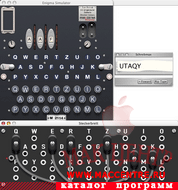

- #OSX ENIGMA SIMULATOR INSTALL#
- #OSX ENIGMA SIMULATOR SOFTWARE#
- #OSX ENIGMA SIMULATOR SIMULATOR#
- #OSX ENIGMA SIMULATOR DOWNLOAD#
Enigma simulator by Dirk Rijmenant for Windows.SDES Key Creation Simulator by Eric Fikus and Jedidiah Crandall.In place of a final exam, there will be a final cipher challenge.

#OSX ENIGMA SIMULATOR DOWNLOAD#
Mathematica can be download and installed here.
#OSX ENIGMA SIMULATOR INSTALL#
See the download instructions to install it on your machine.Īlternatively, you can open a Sage worksheet by connecting to (link will only work on campus or on a machine with a VPN client installed) or just go to the Sage notebook, which is hosted by William Stein at the University of Washington.
#OSX ENIGMA SIMULATOR SOFTWARE#
Sage is free software for algebra and number theory. Homework #11 (due November 19 modified November 17) Homework #8 (due October 29 modified October 20) Homework #5 (due October 8, updated September 30) The use of computers is permitted on other problems, but should not take the place of practice and conceptual understanding. In particular, write the solution up on your own.Ĭertain problems will be computational in nature and the use of computer algebra packages such as Mathematica or Sage is encouraged. Some of the problems may require you to consult the text-this is an intentional effort to encourage you to read the required and recommended books throughout the course.Ĭooperation on homework is permitted (and encouraged), but if you work together, do not take any paper away with you-in other words, you can share your thoughts (say on a blackboard), but you have to walk away with only your understanding. Correct but incomplete answers will only receive partial credit.

Be sure to show your work and explain how you got your answer. Computationally-minded individuals are especially welcome! The class will be driven by applications and examples. The course will be offered at a 295 level intended for undergraduates with a minimal background and at a 395 level for graduate students or others who are seeking a challenge. We will cover some subset of the following topics: conventional encryption techniques, the Hill cipher, DES and SDES, RSA, the Rijndael cipher, discrete logarithms and the Diffie-Hellman key exchange, and elliptic curve cryptography.Īll mathematical objects will be defined, so the prerequisites are minimal: Math 52 or 124, or permission should suffice. The ability to encrypt secrets and to conduct a trusted exchange of digital information, once a subject of interest primarily to governments and the military, is now a matter of necessity for us all.Īt the end of the day, the foundation of modern cryptography relies upon the difficulty of solving certain mathematical problems this course is intended to address them from both a mathematical and algorithmic point of view. As a result, the security of our information is of the utmost concern, even as the interconnectedness of the Internet makes our data more vulnerable to attack. We live an information age, with technology increasingly integrated into our daily lives. Silverman, An Introduction to Mathematical Cryptography (Undergraduate Texts in Mathematics), Springer, 2008, and its homepage. Johannes Buchmann, Introduction to Cryptography (Undergraduate Texts in Mathematics), second edition, Springer, 2004. Washington, Introduction to Cryptography with Coding Theory, second edition, Prentice Hall, 2005.

Where P is the plugboard, L, M and R are the left, middle and right rotors The transform, E, in this formulation, can The transformation of each letter is implemented as a product of permutations With the common 8 rotors and 3 reflectors. An implementation of the Enigma machine in Python.


 0 kommentar(er)
0 kommentar(er)
